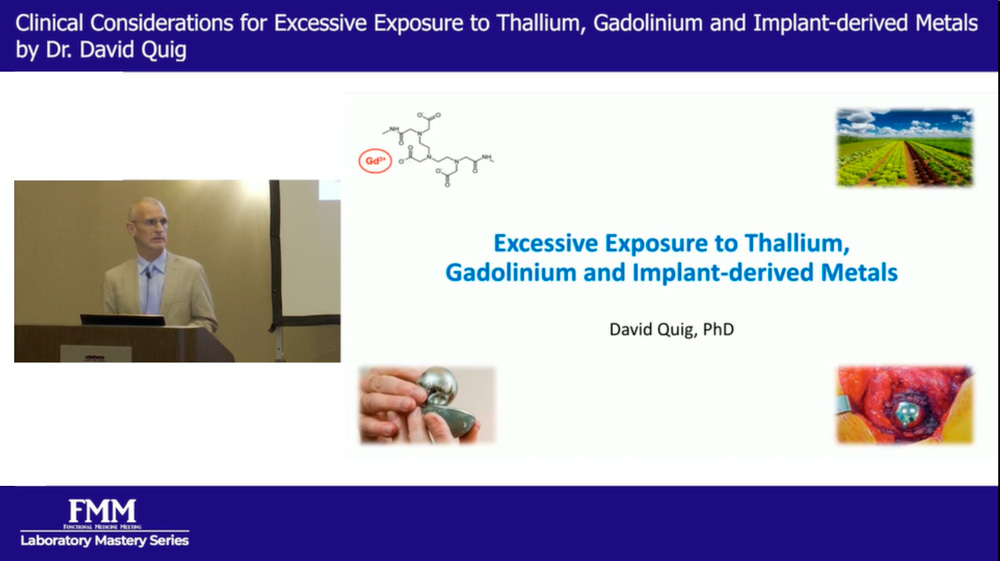Description
This presentation will address the recent biomedical/environmental research that indicates potential adverse physiological impacts of excessive exposure to several metals that patients were previously not commonly exposed to. The sources of exposure, potential symptoms, toxicokinetics and known mechanisms of toxic effects will be discussed. The basic pharmacokinetics of F.D.A. approved gadolinium-based contrast agents will be presented. The standards of care with respect to assessing exposure will be provided, as well as documented clinical efforts to enhance metal decorporation in extreme cases of exposure (case reports). The primary objective is to increase awareness to the aforementioned issues, and inform as to the current standards of medical care.
Relevance to the medical profession
The F.D.A. recently issued a statement addressing the safety of the use of linear verses cyclic gadolinium-based pharmaceuticals for use with MRI testing. Environmental thallium (Tl) exposure has increased due to industrial practices, and the neurotoxic effects of Tl are well established. Numerous publications indicate that metal-on-metal hip arthroplasty may result in perpetual release of excessive cobalt, trivalent chromium and titanium ions, and such may result in periprosthetic tissue damage, implant failure and systemic issues. Such implants are no longer commonly used and guidelines have been established to annually monitor circulating metal levels in recipient patients.
Key Learning Objectives:
After this presentation attendees should be able to:
Thallium (Tl)
Discuss the current increase in dietary exposure to Tl
Explain the standard of care for assessing exposure to Tl, and discuss the most common symptoms associated with excessive exposure
Apply the basic principles of clinical toxicology with emphasis on reducing exposure
Explain the mechanisms of action of Prussian Blue for potential use to enhance biliary/fecal excretion of Tl for symptomatic patients with prolonged high exposure
Gadolinium (Gd)
Explain the potential concerns associated with high Gd retention in patients with compromised glomerular filtration
Select Gd-based contrast agents considering the inherent differences in pharmacokinetics therein
Apply the appropriate means and considerations for the assessment of inadequate clearance of injected Gd
Metal-on-metal total hip arthroplasty (MOM-THP)
Explain the issue of excessive release of the specific metals in periprosthetic tissues and blood associated with MOM-THP implant failure
Discuss acknowledged potential adverse systemic effects of excessively high circulating levels of cobalt associated with MOM-THP implant failure
Integrate into clinical practice the recommendations for monitoring circulating metal debris for asymptomatic and symptomatic patients following MOM-THA
Discuss the potential use of aminothiols and metal decorporation agents post-revision surgery
Outline. (Include MOA and/or allopathic drug reference.)
Thallium – primary dietary sources of exposure, toxicology/toxicokinetics, assessment of exposure, clinical intervention (including selective use and pharmacology/MOA of Prussian Blue)
Gadolinium (Gd) – effective use as a Gd-based contrast agent, pharmacology of linear verses cyclic Gd-based agents, at risk patients (compromised GFR), Nephrogenic Systemic Fibrosis, evidence for potential deposition of Gd in the central nervous system, preliminary research regarding efficacy of DTPA and Calcium Disodium Versonate for enhancement of elimination of Gd from circulation (currently off-label use)
Metal-on-metal total hip arthroplasty (MOM-THA)
History, composition of prosthesis, release of metals (physical wear verses electrocorrosion), pseudotumors and implant failure, assessment of circulating levels of cobalt, trivalent chromium and titanium, potential adverse effects associated with excessive cobalt and titanium release, revision surgery, clinical intervention to lower metal levels post-revision-documented aminothiols, and extreme cobaltism and possible use of 2, 3-dimercapto-1-propane sulfonate (DMPS) and Calcium Disodium Versonate (case reports)
 Dr. Quig received his BS and MS degrees in Human Nutrition from Virginia Tech and a PhD in Nutritional Biochemistry from the University of Illinois. After a five year stint as a Research Associate studying lipid biochemistry and cardiovascular disease at Cornell University, he was a Senior Cardiovascular Pharmacologist for seven years. For the past 23 years David has been the Vice President of Scientific Support for Doctor’s Data, Inc. He has focused on the influence of the gastrointestinal metabolome on overall health, toxic elements, methylation and amino acid metabolism, and the applied biochemistry of endogenous detoxification.
Dr. Quig received his BS and MS degrees in Human Nutrition from Virginia Tech and a PhD in Nutritional Biochemistry from the University of Illinois. After a five year stint as a Research Associate studying lipid biochemistry and cardiovascular disease at Cornell University, he was a Senior Cardiovascular Pharmacologist for seven years. For the past 23 years David has been the Vice President of Scientific Support for Doctor’s Data, Inc. He has focused on the influence of the gastrointestinal metabolome on overall health, toxic elements, methylation and amino acid metabolism, and the applied biochemistry of endogenous detoxification.

